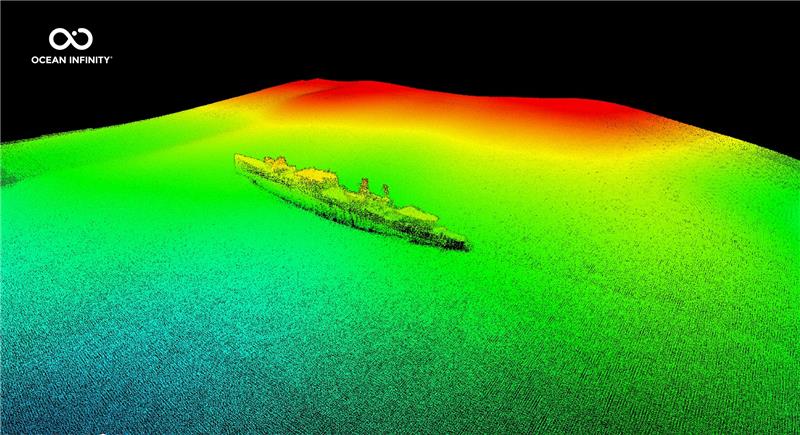Undersea investigators have located the wreck of a century-old US Navy destroyer, USS Stewart, that was lost for nearly 80 years. The wreck, once known as “The ghost ship of the Pacific”, was found off the coast of northern California 1,067 meters (3,500 feet) below the water’s surface.
USS Stewart was found within the boundaries of the Cordell Bank National Marine Sanctuary by an extensive collaborative expedition between Ocean Infinity, the Air/Sea Heritage Foundation, SEARCH, NOAA’s Office of National Marine Sanctuaries, and the Naval History and Heritage Command (NHHC).
The mission to find the sunken vessel involved sending autonomous underwater drones developed by Ocean Infinity to conduct an extensive and methodical scan of the seafloor that took 24 hours to complete. Once the data was retrieved, it showed the incredible image of the sunken ship resting upright on the seafloor.
A multibeam scan of USS Stewart resting on the seafloor.
Image courtesy of Ocean Infinity.
The Stewart was built in Pennsylvania, Philadelphia, in September 1919 and commissioned in September 1920. Although it was too late to take part in World War I, the vessel saw frontline action during World War II. In 1941, when the Stewart was stationed in Manila as part of the Asiatic Fleet tasked with opposing Imperial Japan’s advances.
Then, in 1942, disaster struck as the vessel was damaged during combat and a freak accident trapped it in a repair drydock in Java. The crew was forced to abandon the Stewart as Japanese forces prepared to take the island – but this was not the end of the ship’s story.
Raised and repaired, the vessel was pressed into service by the Imperial Japanese Navy as Patrol Boat No. 102 and was seen by Allied pilots operating well beyond enemy lines.
The USS Stewart has become a habitat for various ocean life since it sank. Despite this, the vessel is remarkably well preserved.
Image courtesy of Ocean Infinity.
Then, after the war ended, the Stewart was found afloat in Kure, Japan, and returned to San Francisco by the US Navy. In what was described as a final “emotional ceremony” in a statement, the Stewart was given a burial at sea in 1946 when it was targeted and sunk by aerial rockets, machinegun, and naval guns.
“The whole history of that ship was actually exceptionally well documented,” Russ Matthews, president of the Air/Sea Heritage Foundation, told the New York Times. “The only piece of that story we didn’t have is, what does it look like today?”
Matthews spent years trying to located the sunken vessel before he collaborated with Ocean Infinity. In April 2024, Matthews had the coordinates for the Stewart’s last floating place, and the idea of sending drones to scan the seafloor for its wreckage was proposed.
Scans conducted by the underwater drones indicate that the ship is largely intact and still appears “sleek and imposing”. It has an “exceptional” level of preservation for its age and may well be the best-preserved example of a US Navy “four stacker” destroyer known to exist.
After the initial discovery, the team recorded an additional high-resolution sonar survey before launching a detailed visual inspection of the site using a camera-equipped drone. The video feed was sent to the surface via virtual satellite link where experts and stakeholders could see it resting in the depths.
When the Stewart was returned to California, it was called “RAMP-224” by sailors, which was a combination of the vessel’s navy hull number and a slang term for returning prisoner’s of war, “Recovered Allied Military Personnel”.
“It’s clear they thought of Stewart more like a shipmate than a ship,” Matthews said in the statement, “and I know I speak for the entire expedition team when I say that we’re all very satisfied to have helped honor the legacy and memory of those veterans once again.”
The vessel was sunk by the US Navy of the coast of California in 1946 and has been lost ever since.
Image courtesy of Donald M. McPherson/US Naval History and Heritage Command.
“The USS Stewart represents a unique opportunity to study a well-preserved example of early twentieth-century destroyer design. Its story, from US Navy service to Japanese capture and back again, makes it a powerful symbol of the Pacific War’s complexity,” Dr James Delgado, now Senior Vice President of SEARCH, added.
This is not the first sunken vessel Ocean Infinity has identified. In 2020, they and SEARCH discovered the USS Nevada. Then, in 2022, Ocean Infinity helped find the Endurance, the legendary and fated ship that carried Captain Ernest Shackleton and his crew toward Antarctica in 1915.
It seems these new autonomous underwater drones may well be ushering in a new era of ocean discovery, so perhaps the Stewart is just one of many more lost vessels that will soon be rediscovered.
Source Link: USS Stewart, The World War II "Ghost Ship Of The Pacific", Discovered Off California Coast
